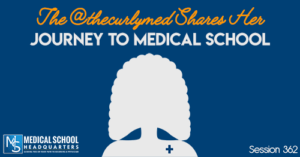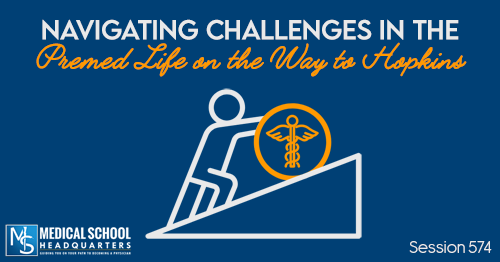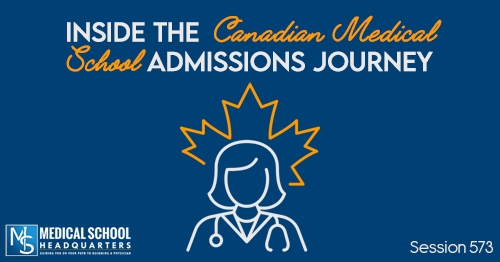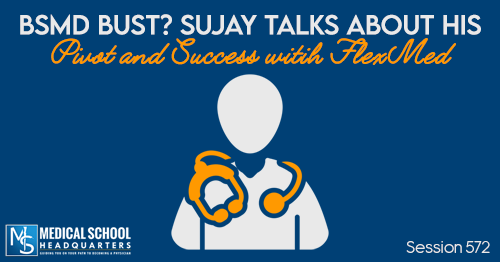Apple Podcasts | Google Podcasts

Session 362
Sabina, better known as @thecurlymed on Instagram, shares her amazing journey to medical school. We’ll also talk about advising, postbacs, and LGBTQ identity.
Listen to this podcast episode with the player above, or keep reading for the highlights and takeaway points.
[01:25] Interest in Medicine
Sabina has always wanted to become a doctor since she was five. Aside from being a genuinely curious human being, her brothers had medical complications at birth. This sparked her interest. But it was the public health aspect that really kept her going.
'What kept me going was seeing how intricate the medical field is and the width of impact I could have as a physician beyond just knowing more about the human body.'Click To TweetSabina went to the University of Pennsylvania for undergrad. One of the major reasons she chose it was because of the research and science opportunities. And this helped shape her decision to become premed.
Additionally, she wanted to have gender and sexuality studies, which was her original major Then she took a neuroscience course which she fell in love with. It also happened to be a premed major at Penn so she switched to doing a major in neuro and minor gender studies.
[Related episode: Is Research More Important than Clinical Experience?]
[05:15] Dealing with a Competitive Premed Environment
Sabina admits that she fell behind initially being a very competitive environment. This was a struggle for her and everything just contributed to how she felt about herself. That being said, she had no regrets going to Penn because such experience has given her the drive and motivation she has now.
'Impostor syndrome was really the hardest for me and learning how to seek help and know that it's okay to not be okay.'Click To TweetHer biggest struggle was overcoming the initial setback. She fell behind quickly during freshman year. She didn’t know how to ask for help. She was embarrassed by all of it. She was watching everybody else excel.
By her junior year, she took a deep dive into herself to ponder on what she really wanted to do. She knew she had been trying for two years and it wasn’t working so she knew she had to get the help she needed.
Partially, it was the culture at Penn that held her back from asking for help, but Sabina is brave enough to own up for 60% of it. She also knew that if she had found the courage to ask for help earlier then she would have gotten it regardless of the culture.
To those struggling at their schools, Sabina encourages students to go to their advisors. Seek that kind of help.
If you’re struggling with classes specifically, go to your professors. Don’t be embarrassed to talk to them about your issues. They’re there for you to help you. This actually contributed largely to her upward swing by junior and senior year.
'There are amazing advisors out there. But if you do encounter advisors that aren't going to support you then definitely run fast and far away.'Click To TweetAfter her first premed advising session, she never came back. But this didn’t discourage her either. She knew she was going to try regardless. She sought help from her general college advisor after much research about her options.
[Related episode: Can I See Your Stats to See How Competitive I Am?]
[13:11] Working on Her GPA and MCAT
Sabina had a 2.8 overall GPA and a 2.55 science GPA. She applied to postbac program, a special master’s program, and a master’s program.
She knew her extracurriculars were great. She had great leadership and consistency. She was passionate and all that stuff. It was just the numbers game she knew she had to play. Ultimately, she got accepted to one master’s program and it was obviously the only option she had. She did it anyway. She took a master’s in science and biology and killed it with a 4.0 GPA.
She went on to take her MCAT after that, which she knew she needed to do as well. She ended up getting a 509.
Sabina stayed consistent and passionate about it throughout the whole thing. Initially, she was nervous about going into master’s program because of how she did in her sciences at Penn. She knew she can’t mess around since it was her one chance to do well so she completely changed how she studied.
'I studied in a way that worked for me.'Click To TweetSabina changed the way she studied, using whiteboards and teach-backs to her classmates. She became close friends with her professors too which she believed ultimately helped her.
One of the most common mistakes incoming students make is focusing too early on those extracurriculars and not learning how to be a college student. For Sabina, once she started her extracurriculars, she felt so better that she forgot about the academic side of things.
She did shadow a couple of times, but she mostly doing event planning for the student government. She was working in the community, teaching science to elementary and high school level kids in West Philadelphia. She found these to be very rewarding, which kept her going through her undergrad.
[Related episode: Calculating Premed GPA and other Listener Questions]
[24:10] The Interview Process
How Sabina identified related to strongly to her “why” for medicine so there was no way for her to leave this out in her application. Being part of the LGBT community, she made this very clear in her personal statement as well as throughout her entire application. This was something she wanted to do in her career long-term.
'I don't want to go somewhere that isn't going to be able to provide me with that type of support.'Click To TweetShe got 6 interviews. In the end, she was asked if there was something she wanted them to take back to the community. The interviewers didn’t ask her about her grades since 4 of them didn’t have access to them. But for the other two, she talked about what she did to make that shift showing an upward trend.
[Related episode: 5 Common Med School Interview Questions and How to Answer Them]
[26:50] Hardest Part of Being Premed
For Sabina, staying throughout the course was the hardest part for her. She took three gap years. It was hard to stay focused and motivated throughout the whole thing. It was the easiest part for her too since she was so determined to get to where she wanted to be.
[28:00] Running @thecurlymed
Sabina started her Instagram account right before she submitted her AMCAS application. She did it to seek out people online who have gone through something like her. But she wasn’t finding it. So she decided to be the person for whoever needs it.
Additionally, this was a way for her to track her journey regardless if she gets in or not. She wanted people to see how it was like from beginning to end. Luckily, it ended up with a seat in medical although initially, she didn’t know where it would land.
'My initial motivation was to provide advice and guidance for people who are in a similar boat as me.'Click To TweetMoreover, Sabina credits having a great support system throughout this journey. Finally, she wishes to tell other students similar to her situation struggling with grades that it’s possible. It may take a while and it’s definitely going to take a lot of hard work.
If you’re serious about being a doctor and getting into medical school, realize the amount of work that it’s going to take to overcome those numbers.
Links:
Follow Sabina on Instagram @thecurlymed











